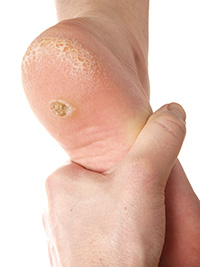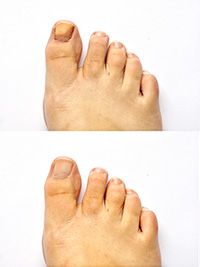What is a verruca?
A verruca is a viral infection of the skin on the foot, also known as a wart. They can vary in size and appearance depending on the viral strain of the verruca – those of you who have read my blog will know there are many different strains of the virus -and identifying this will help us to recommend you the best course of treatment.
Sometimes several verrucas (verrucae) appear on the foot and may be present on your hands as well. A verruca normally starts to appear as a speckled area and grows very rapidly. It can be painful if pinched or when pressure is applied on it directly e.g. on the heel area.
How do you get a verruca?
 The virus is picked up through physical contact with an area already infected by someone else with a verruca, but can remain dormant for some time before appearing. The virus enters the skin through a tiny break or split in the skin. This normally happens where bare foot activity takes place, especially in areas with damp conditions such as swimming pools and communal showers. Please take extra care when rushing off to the gym – we recommend that you wear verruca socks or flip-flops in communal areas to reduce the chance of this painful foot infection.
The virus is picked up through physical contact with an area already infected by someone else with a verruca, but can remain dormant for some time before appearing. The virus enters the skin through a tiny break or split in the skin. This normally happens where bare foot activity takes place, especially in areas with damp conditions such as swimming pools and communal showers. Please take extra care when rushing off to the gym – we recommend that you wear verruca socks or flip-flops in communal areas to reduce the chance of this painful foot infection.
Treatment of verrucas
As with all viral infections, the body’s immune system must respond in order to clear the virus from your system.
Whilst early treatment is always to be recommended, not least to avoid spreading the infection to family members, more intensive treatment is only normally needed for verrucae which have been present for more than two or three months, or are particularly painful, increasing in size or multiplying. Persistent cases are unlikely to resolve themselves.
At Tiptoe Foot Care we offer a variety of verruca treatments including freezing, dry needling or caustic acid treatments, to help stimulate the body’s immune response in killing the virus. After discussing your lifestyle needs, we will formulate a personal treatment plan that we believe is most likely to be effective given the strain of virus you have and minimise pain or discomfort. We understand that work, travel or sporting commitments might require a different style or speed of treatment and will help you to decide on your preferred option although we are keen to avoid unnecessary scarring.
What is athlete’s foot?
Athlete’s foot is a fungal infection of the skin. It can cause immense itchiness, and cracking, blistered or peeling areas on your feet. It sometimes appears red and scaly.
If left untreated the fungal infection can spread to the nails which can then be very difficult to treat. The infected nails can appear thickened or crumbly, and will usually become unsightly and discoloured.
How do you catch athlete’s foot?
A number of fungal species can cause athlete’s foot, and the initial infection can be picked up from any infected area where you walk barefoot. The most common place to pick it up is in communal areas such as public showers, swimming pools and changing rooms.
Treatment of athlete’s foot
 Once you have an infection, the fungi breed in shoes, where they have an ideal environment of warmth, darkness and moisture. Good foot hygiene, including regularly changing and cleaning your socks and shoes, is therefore an important step in controlling the infection.
Once you have an infection, the fungi breed in shoes, where they have an ideal environment of warmth, darkness and moisture. Good foot hygiene, including regularly changing and cleaning your socks and shoes, is therefore an important step in controlling the infection.
When you see the podiatrist, we can help to identify the strain of the fungus and establish the best course of treatment for your particular type of athletes’ foot. Early action and advice can help to stop the infection from spreading and avoid more intensive treatments being needed.
However, if the infection has already spread to the nails we can help by cutting back affected nails, reducing thickened nails and advise on a suitable course of action. We can also provide cosmetic solutions that are great for holidays or special occasions whilst we continue to clinically treat the infection underneath.
